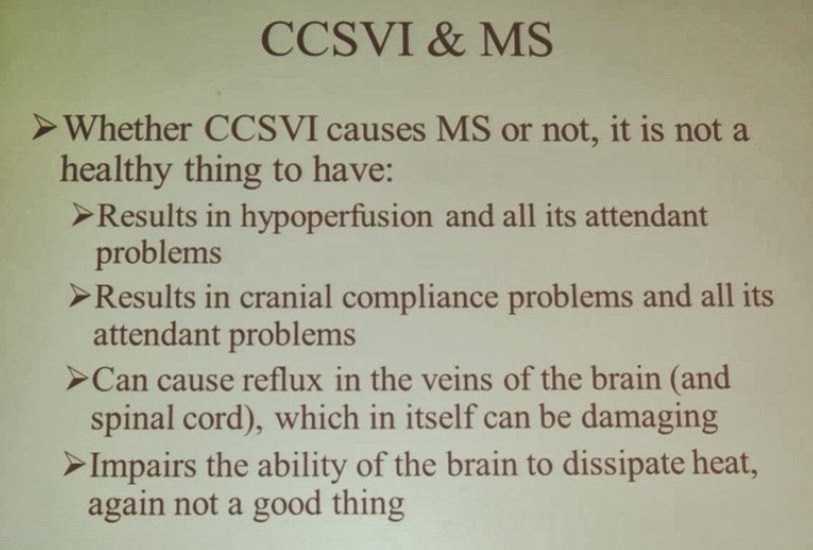The International Union of Phelebology on maailman suurin laskimosairauksien asiantuntijoiden järjestö, joka aika ajoin päivittää määrityksiä ja ohjeistuksia laskimosairauksien suhteen. Nyt 2013 päivityksessä CCSVI:stä oli pitkähkö teksti ja oli ilahduttavaa todeta, että laskimoasiantuntijoille CCSVI on todellinen tila, siis oma diagnoosi. Tekstissä määriteltiin mm. mitä CCSVI on, mitä se aiheuttaa ja miten se todetaan. Useimpia ehkä kiinnostaa se, että mitä CCSVI aiheuttaa ja tekstissä esitettiin tutkimukseen perustuvana tietona se, että
se aiheuttaa verenvirtauksen heikentymistä keskushermostossa eli hypoperfuusiota (kuten MS-potilailla) ja myös
selkäydinnesteen heikompaa virtausta.
Näin maallikon silmin tilanne on nyt erikoinen, kun ilmiöstä tulee kahdenlaista näkemystä. Itse luotan siihen, että laskimoasiantuntijat ovat oman alansa asiantuntijoita ja järjestön näkemys asiasta on siten oikeilla raiteilla.
Linkki:
GUIDELINE - DIAGNOSIS AND TREATMENT OF VENOUS MALFORMATIONS
CCSVI teksti sivulta 51 eteenpäin:
"Chronic cerebrospinal venous insufficiency (CCSVI) is a syndrome characterized by
restricted venous outflow from the brain, in consequence of respectively intraluminal
defects, wall stenosis, or also external compression, striking the internal jugular (IJV)
and/or azygos veins. Intraluminal obstacles and hypoplasia\agenesis, documented with a
combination of techniques (intra and extravascular ultrasounds, catheter and MR
venography) are morphologically quite similar to those above described for truncular
VMs.
The reported prevalence of CCSVI is highly heterogeneous in literature. However, a
meta-analysis reveals that CCSVI was found mainly in multiple sclerosis patients, but
also possibly associated to other neurodegenerative diseases and even to healthy controls.
In CCSVI usually more than one segment of the major extra-cranial and extravertebral
cerebral veins is affected. Consequently, disturbed flow and formation of collateral
venous channels have been described. The IJV flow objectively measured by means
of 2D MR drains approximately 75% of the cerebral arterial inflow, whereas it falls to
respectively 64% and 52% if one or two stenosis are documented.
The extensive flow diversion through collaterals channels, permits to avoid intra-cranial
hypertension. Venous hypertension in cerebral veins was never assessed. However, a
slight but significant gradient across the stenosis has been measured.The two main
consequences of CCSVI on brain pathophysiology have been recently highlighted by the
means of objective non conventional MRI measures:
1)
Impaired brain perfusion. Venous outflow obstruction determines diffuse
hypoperfusion of the brain parenchyma(e.g. multiple sclerosis patients).
2)
Impaired cerebro-spinal fluid (CSF) dynamics. CSF is ultra-filtered at the level of the
lateral ventricles, circulates in the CSF spaces and finally is re-absorbed into the venous
system, at the level of the superior sagittal sinus.
In CCSVI, impaired cerebral venous outflow is linearly related to the impaired venous
hemodynamics. Finally, Color Doppler sonography and plethysmography both
clearly measure an impaired postural control of cerebral venous return. Passing from
supine to up-right posture the cervical venous outflow is significantly faster in controls
respect to CCSVI.
Summary
Truncular VM as cause of CCSVI is supported by gross anatomy and imaging techniques
evidences of intraluminal defects and segmentary hypoplasia, typically seen in truncular
VMs. In addition, embryology 280 compared with morphologic characteristic of
some CCSVI lesions, further suggests truncular VMs.
Finally, focal alterations in collagen component, and specific genetic and
environmental factors further suggests truncular VMs to explain the origin of CCSVI
stenosing lesions.
Nowadays, there are increasingly thriving studies leading to a CCSVI diagnosis through
multimodal techniques, in which the different methods are used in combination in order
to increase diagnostic accuracy. An ideal screening device is cervical
plethysmography. It tells us how much the venous return is affected but needs to be
corroborated by Doppler sonography, MRV and CT venography to define exactly both morphology
and location of venous obstruction.Invasive catheter venography/phlebography and intravascular
sonography should be used only when treatment is planned.












